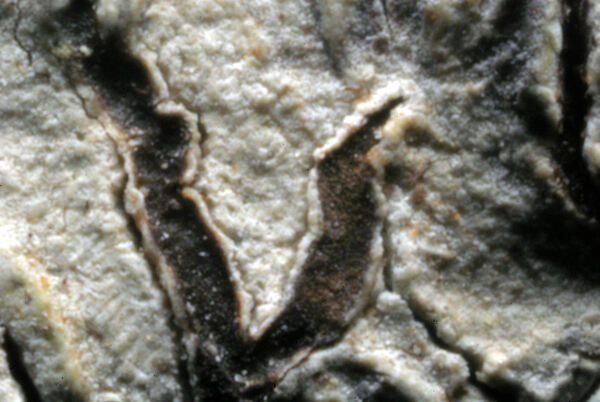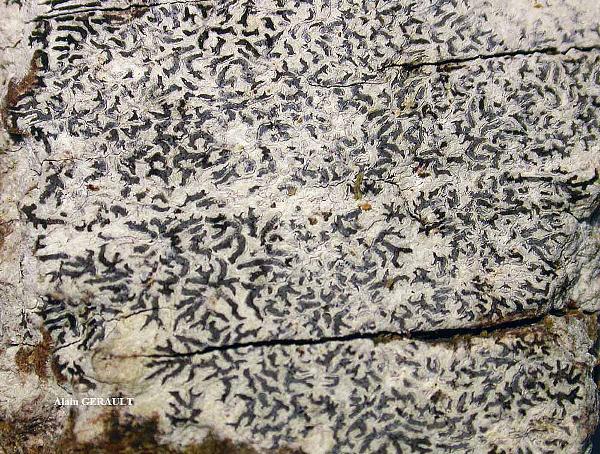Phaeographis smithii (Leight.) B. de Lesd.
Rech. Lich. Dunkerque: 218, 1910. Basionym: Graphis smithii Leight. Ann. Mag. Nat. Hist. - 2, 13: 278, 1854.
Synonyms: Graphis dendritica var. macularis (Leight.) Boistel
Distribution: S - Camp (Nimis & Tretiach 2004, Puntillo & Puntillo 2011, Etayo & Puntillo 2011), Cal (Puntillo & Puntillo 2012).
Description: Thallus crustose, (60-)80-140(-200) µm thick, continuous to rimose, whitish to cream-coloured, dull, not mealy, often delimited by a black prothalline line. Cortex and medulla densely inspersed with large crystals (polarized light!). Apothecia lirelliform, with acute ends, black, level with thallus to slightly raised at maturity, simple or often dendritically branched, straight or slightly curved, 1-2(-2.5) x 0.2-0.3(-0.5) mm, with an expanded, epruinose or rarely faintly whitish-pruinose disc and a proper margin without evident excipular lips; a thin, entire, inconspicuous thalline rim is rarely present in young ascocarps. Proper exciple pale to dark brown, 20-25 µm thick laterally, usually not extending below the hymenium; epithecium brown, 5-15 µm high; hymenium colourless, inspersed with oil droplets, 75-125-140(-200) µm high, I-; paraphyses coherent, c. 1.5 µm thick, sparsely branched in upper part, with brownish, slightly expanded, to 2 µm wide apical cells; subhymenium hyaline; hypothecium colourless, yellowish to pale brown. Asci 8-spored, clavate, to cylindrical-clavate, non fissitunicate, dehiscent by an apical split, K/I-, Graphis-type. Ascospores (3-)5-6(-8)-septate, with lens-shaped cells, at first hyaline but soon turning brown, narrowly ellipsoid, (20-)25-35(-42) x (6-)8-10(-13) µm, I+ red or reddish brown. Photobiont trentepohlioid. Spot tests: cortex and medulla K+ yellow turning orange-red (reaction of slow and patchy!), C-, KC+ red, P+ yellow-orange, UV-. Chemistry: norstictic and connorstictic acids.Note: a mild-temperate to humid subtropical, mainly Atlantic species in Europe, known from only two hyperhumid stations in Italy. It is included in the Italian red list of epiphytic lichens as “Critically Endangered” (Nascimbene & al. 2013c).
Growth form: Crustose
Substrata: bark
Photobiont: Trentepohlia
Reproductive strategy: mainly sexual
Restricted to humid-warm, oceanic areas
Commonnes-rarity: (info)
Alpine belt: absent
Subalpine belt: absent
Oromediterranean belt: absent
Montane belt: absent
Submediterranean belt: absent
Padanian area: absent
Humid submediterranean belt: absent
Humid mediterranean belt: extremely rare
Dry mediterranean belt: absent
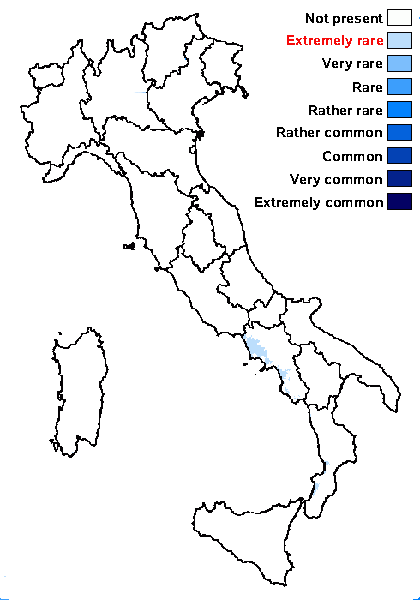
Predictive model
Herbarium samples
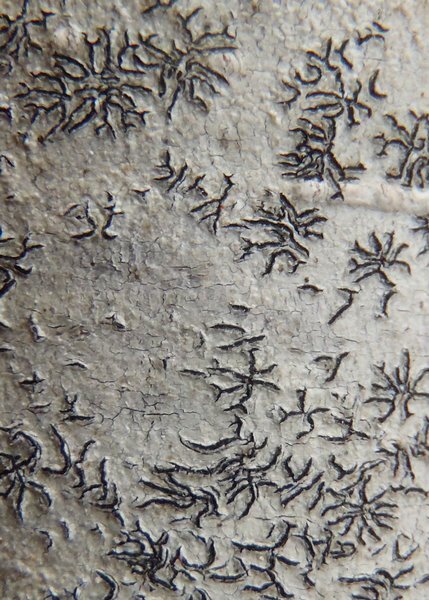

Curtis Randall Björk – CC BY-SA 4.0
British Columbia, Coast Ranges, Bute Inlet Date: 2009-09-04 Photographed from specimen (Björk 19779, UBC), on trunk Alnus rubra in rainforest, in waterfall sprayzone


P.L. Nimis; Owner: Department of Life Sciences, University of Trieste
Herbarium: TSB (31902)
2003/03/17
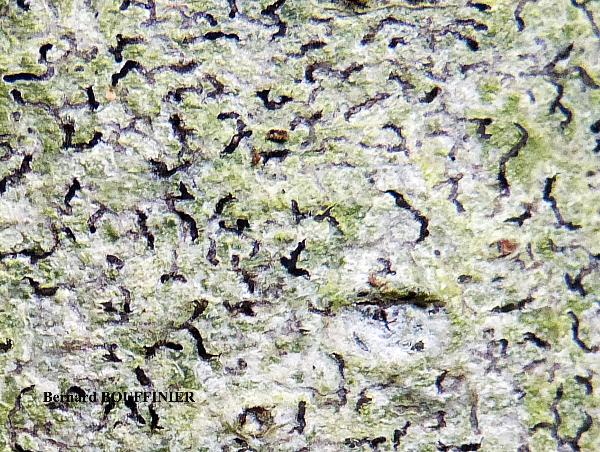
Bernard Bouffinier - Source: http://www.lichensmaritimes.org/index.php?task=fiche&lichen=628&lang=en
France, Aber Poraon
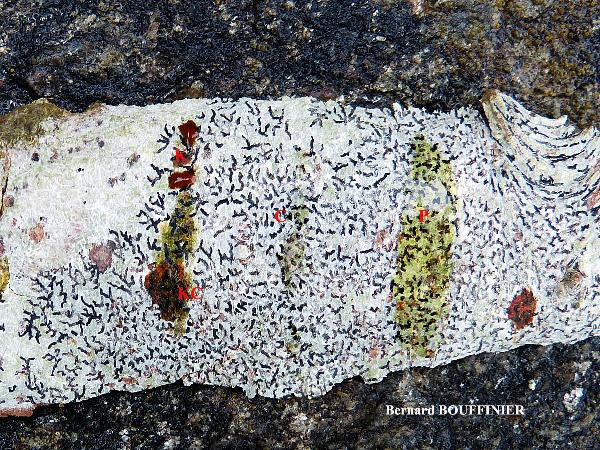
Bernard Bouffinier - Source: http://www.lichensmaritimes.org/index.php?task=fiche&lichen=628&lang=en
France, Aber Poraon
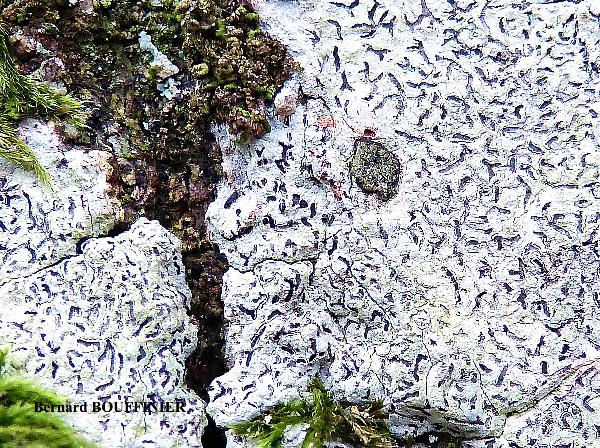
Bernard Bouffinier - Source: http://www.lichensmaritimes.org/index.php?task=fiche&lichen=628&lang=en
France, Crozon Kéroulé
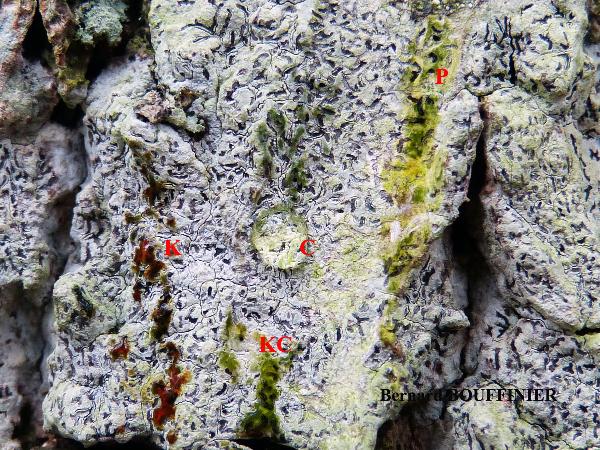
Bernard Bouffinier - Source: http://www.lichensmaritimes.org/index.php?task=fiche&lichen=628&lang=en
France, Crozon Kéroulé
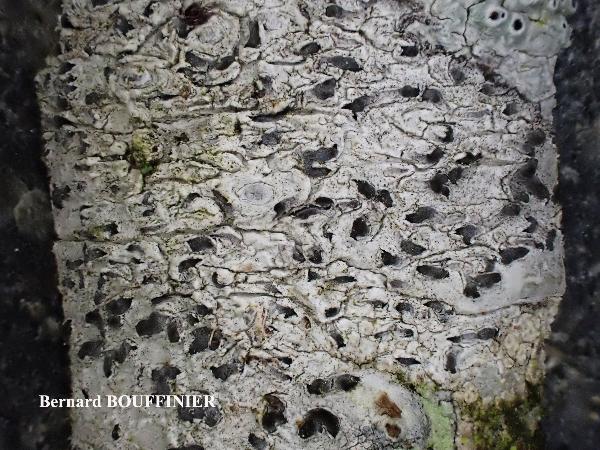
Bernard Bouffinier - Source: http://www.lichensmaritimes.org/index.php?task=fiche&lichen=628&lang=en
France, Postolonnec
Growth form: Crustose
Substrata: bark
Photobiont: Trentepohlia
Reproductive strategy: mainly sexual
Restricted to humid-warm, oceanic areas
Commonnes-rarity: (info)
Alpine belt: absent
Subalpine belt: absent
Oromediterranean belt: absent
Montane belt: absent
Submediterranean belt: absent
Padanian area: absent
Humid submediterranean belt: absent
Humid mediterranean belt: extremely rare
Dry mediterranean belt: absent

Predictive model
| Herbarium samples |


Curtis Randall Björk – CC BY-SA 4.0
British Columbia, Coast Ranges, Bute Inlet Date: 2009-09-04 Photographed from specimen (Björk 19779, UBC), on trunk Alnus rubra in rainforest, in waterfall sprayzone


P.L. Nimis; Owner: Department of Life Sciences, University of Trieste
Herbarium: TSB (31902)
2003/03/17

Bernard Bouffinier - Source: http://www.lichensmaritimes.org/index.php?task=fiche&lichen=628&lang=en
France, Aber Poraon

Bernard Bouffinier - Source: http://www.lichensmaritimes.org/index.php?task=fiche&lichen=628&lang=en
France, Aber Poraon

Bernard Bouffinier - Source: http://www.lichensmaritimes.org/index.php?task=fiche&lichen=628&lang=en
France, Crozon Kéroulé

Bernard Bouffinier - Source: http://www.lichensmaritimes.org/index.php?task=fiche&lichen=628&lang=en
France, Crozon Kéroulé

 INDEX FUNGORUM
INDEX FUNGORUM
 GBIF
GBIF


